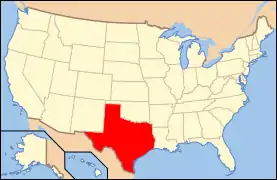Monte Verdi Plantation
The Monte Verdi Plantation is a historic forced-labor farm in Rusk County, Texas, where enslaved Black people grew cotton for white owners.
Monte Verdi Plantation | |
 Monte Verdi Plantation  Monte Verdi Plantation | |
| Location | 11992 CR 4233, Cushing, Texas |
|---|---|
| Coordinates | 31°54′6″N 94°52′15″W |
| Area | 100.00 acres (40.47 ha) |
| Built | 1854 |
| Architectural style | Greek Revival |
| Website | Monte Verdi Plantation |
| NRHP reference No. | 14000104[1] |
| RTHL No. | 11021 (Plantation) 10960 (Birdwell House) |
| Significant dates | |
| Added to NRHP | March 31, 2014 |
| Designated RTHL | 1964 (Plantation) 1967 (Birdwell House) |
History
Julien Sidney Devereux, a member of the Sixth Texas Legislature, purchased land from 1845 onwards.[2] By 1849, he called it Monte Verdi, which means "green mountain" in Italian.[2] By 1850, 74 enslaved African people worked on the plantation.[2] They produced 120 bales of cotton every year, making it one of the 100 most productive plantations in Texas.[2] At its peak, the plantation covered 10,700 acres.[3]
The mansion was built from 1856 to 1857.[2] It was designed in the Greek Revival architectural style.[2] It is two story high, with six Doric columns and a balcony on the second floor.[2] It was restored by Emmett F. Lowry and his wife in the early 1960s.[2]
In 1962, historian Dorman H. Winfrey wrote a history of the plantation entitled Julien Sidney Devereux and His Monte Verdi Plantation, published by the Waco-based Texian Press.[4]
Historic site
The plantation house has been a Recorded Texas Historic Landmark since 1964.[2] Additionally, the 100-acre core of the plantation has been listed on the National Register of Historic Places since March 31, 2014.[2] The historic core area preserves the history of a large forced-labor cotton farm, active for many years surrounding the Civil War. The Greek Revival plantation house is a good example of its type and retains much of its original materials. The main house, restored in 1960, has an L-shaped plan for the first floor and a rectangular plan for the second; a total of 2960 square feet. The plantation main house and a water well are historic structures at the site, which also includes a relocated house and several structures of more recent vintage that are not contributing resources.[3]
The plantation includes the Birdwell House, a Recorded Texas Historic Landmark designated in 1967. The c. 1840 house, originally located in Mount Pleasant, is a noncontributing building to the plantation as it was moved to the property after the period of historic significance for the plantation's NRHP nomination and has been removed from its original context.[3]
See also
References
- "Weekly list of actions taken on properties: 3/31/14 through 4/05/14". National Park Service. April 11, 2014. Retrieved April 7, 2015.
- Christopher Long, "MONTE VERDI PLANTATION," Handbook of Texas Online (https://tshaonline.org/handbook/online/articles/ccm02), accessed April 04, 2015. Uploaded on June 15, 2010. Published by the Texas State Historical Association.
- Jake McAdams; Carlyn Hammons (May 2013). "National Register of Historic Places Registration Form: Monte Verdi Plantation" (PDF). National Park Service. Retrieved 2015-04-07. Includes photos.
- Dorman H. Winfrey, Julien Sidney Devereux and His Monte Verdi Plantation (Waco: Texian Press, 1962)

